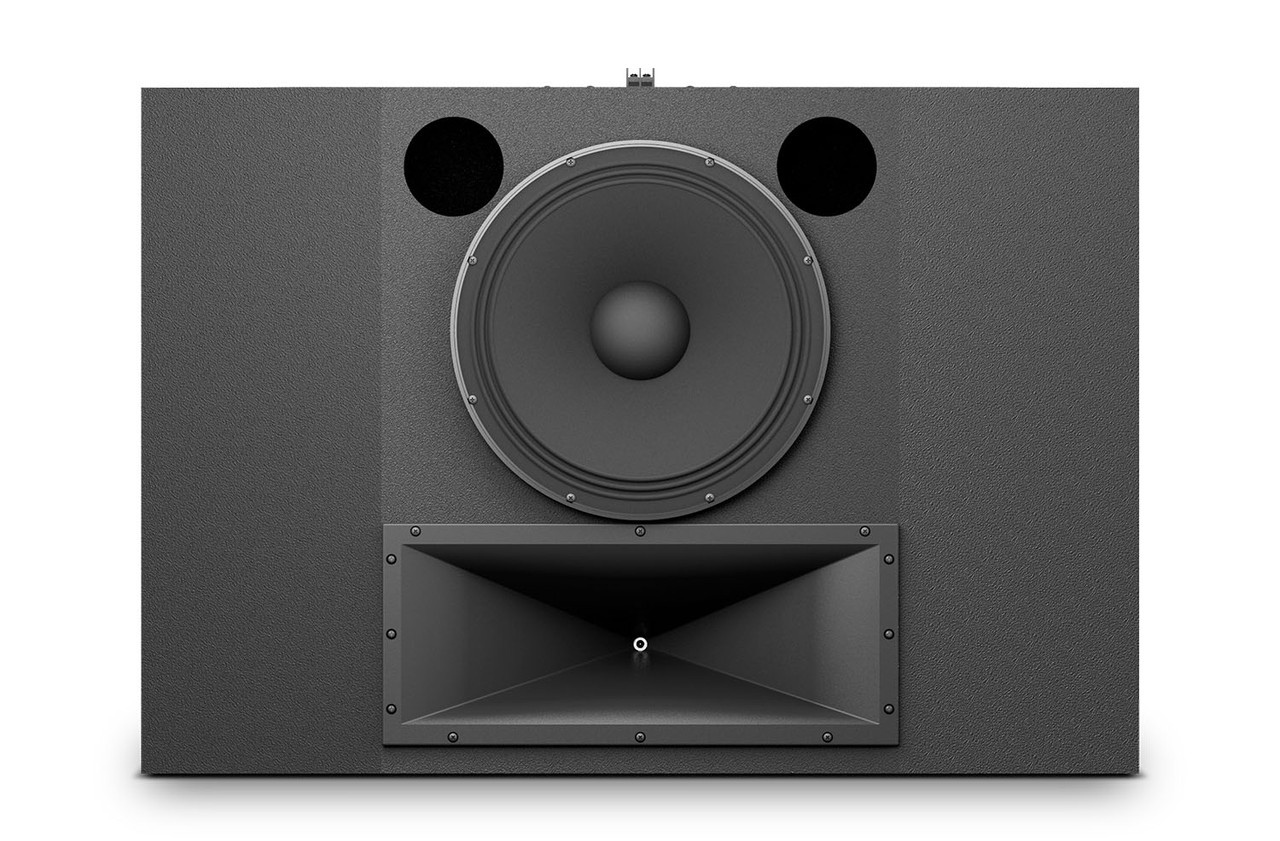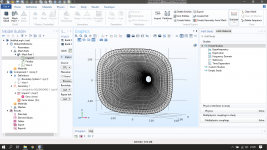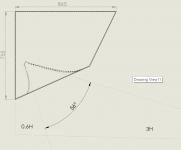You don't need a driver model for a horn simulation. They didn't use it either - a virtual constant acceleration source was used. It's mentioned in one of the slides you showed. It is also what is used in Ath4 sims, BTW.
If you want to vitually optimize 'a system', such as a specific driver-horn combination, it's essential to model the individual parts as accurately as possible. At least that's what I understood from papers and presentations (B&C, Ciare, JBL). Perhaps they didn't deem it necessary in this case.
The phase plug of the latest JBL drivers is rather special. P. Bateman has posted about the specifics in some of his threads.

For a comparison, this is an actual measurement of an "ordinary" horn (with an OS throat) in a box. It has essentially the same beamwidth/polar pattern at 10 kHz as the "optimized" Samsung shown. With the difference that it is much better controlled below that (~95 deg nominal). So where is the appeal?
0 - 120 deg / 10 deg step; normalized to 20 deg (as you can see there are still some slight aberrations around the axis)
Those first STH builds are (still) exceptional wrt performance.
The white baffle + veneered sidepanels looks very good too.
Due to the Sica 12" you don't necessarily need subs, provided the room isn't problematic.
Pet007 did a terrific job on the crossovers.
Last edited:
This is true for the phase plug, etc., i.e. to take the acoustic path in the driver into account (and it's a pity they didn't do/publish it - that could be much more interesting). The "lumped element model" you mentioned is not only not necessary but irrelevant for horn directivity optimization because all it does is some global equalization. You see, they normalize the data in the end, so it would get lost anyway.If you want to vitually optimize 'a system', such as a specific driver-horn combination, it's essential to model the individual parts as accurately as possible. At least that's what I understood from papers and presentations (B&C, Ciare, JBL). Perhaps they didn't deem it necessary in this case.
Re JBL 2409H - I didn't realize at first how tiny it is. From the photos of the optimized horn prototype I got an impression of something like 1.5" driver - then the results would be much more impressive. It's not that hard to do that with a 0.5" driver.
According to JBL they cross it at 1.7 kHz in the "7" series so I guess that's about the lower limit. That makes it hardly usable for bigger speakers (i.e. for even better directivity control). Or maybe it could go lower without a strain - they also needed to match the directivity of the (small) woofer there, so that might really determine the crossover point.
According to JBL they cross it at 1.7 kHz in the "7" series so I guess that's about the lower limit. That makes it hardly usable for bigger speakers (i.e. for even better directivity control). Or maybe it could go lower without a strain - they also needed to match the directivity of the (small) woofer there, so that might really determine the crossover point.
Last edited:
It's a parametric optimization process. I expect 3eepoint to be able to (approximately) duplicate or reverse-engineer it.
He only needs COMSOL and probably an accurate lumped element model of a compression driver. These are usually built in Matlab.
Perhaps Dr. Geddes could be of help in this regard.
I've posted some sheets of the JBL/Samsung presentation here, including the 'wonderful sculpture' that resulted from the optimization process.
It started with this:
Jup, thats pretty much what happend. Only that I handle the constraints and optimisation itself in Matlab rather than COMSOL* and COMSOL can handle Lumped elements. It is a Multiphysics software which can combine several effects. The simulation also uses a Lumped Driver Model as I also optimised cone driver Horns with it where I can model the membrane geometry.
And, to be completely honest, with mabats script my optimisation approach might be outdated annyway as the script takes several days to reach a solution as shown previusly.
*COMSOL tends to ignore constraints crashing the geometry, also, data evaluation is far better handled in Matlab.
Over the years I've collected some files related to Matlab/COMSOL horn optimization.
A Scandinavian optimization study (Master's thesis) of a waveguide for dome tweeters was supported by SEAS that also provided a lumped element model of the dome tweeter.
I've tried to run sims in COMSOL of a waveguide generated with mabat's STH tool, but didn't get far. You really need a deeper understanding of acoustics and electronics to know what you are doing.
In the Samsung presentation cone optimization is also highlighted.
A Scandinavian optimization study (Master's thesis) of a waveguide for dome tweeters was supported by SEAS that also provided a lumped element model of the dome tweeter.
I've tried to run sims in COMSOL of a waveguide generated with mabat's STH tool, but didn't get far. You really need a deeper understanding of acoustics and electronics to know what you are doing.
In the Samsung presentation cone optimization is also highlighted.
Attachments
Last edited:
The mesh quality of the current output is still rather poor. In fact, I'm in a process of a complete redesign of the tool and it will be much better - curvature controlled, not fixed. The new one will have a GUI with interactive paramatric controls and will offer some unprecedented possibilities - I'm utilizing the last waveguide formula which makes it all a piece of cake.
Looks like you are trying to do a FEM Simulation with an BEM Model approach. If you want some Help hit me up.
The mesh quality of the current output is still rather poor. In fact, I'm in a process of a complete redesign of the tool and it will be much better - curvature controlled, not fixed. The new one will have a GUI with interactive paramatric controls and will offer some unprecedented possibilities - I'm utilizing the last waveguide formula which makes it all a piece of cake.
Alright, I am uninstallings Comsol then

Re JBL 2409H - I didn't realize at first how tiny it is. From the photos of the optimized horn prototype I got an impression of something like 1.5" driver - then the results would be much more impressive. It's not that hard to do that with a 0.5" driver.
According to JBL they cross it at 1.7 kHz in the "7" series so I guess that's about the lower limit. That makes it hardly usable for bigger speakers (i.e. for even better directivity control). Or maybe it could go lower without a strain - they also needed to match the directivity of the (small) woofer there, so that might really determine the crossover point.
Behind the rather straightforward waveguide of this JBL 2-way cinema speaker, the same 2409H is mounted as used in the 7-series.
Makes one wonder whether these 'interesting looking' Image Control Waveguides are merely marketing induced cosmetics.

Makes one wonder whether these 'interesting looking' Image Control Waveguides are merely marketing induced cosmetics.
Ya think! 🙄
This is surprising to me, that's a two-way with a 15" woofer. According to datasheet the (horizontal) beamwdith is around 100 degrees nominal, which would mean the crossover won't be higher than about 1 kHz, rather even lower. Must be a fantastic driver (or they compromised the midrange seriously - I believe they didn't).Behind the rather straightforward waveguide of this JBL 2-way cinema speaker, the same 2409H is mounted as used in the 7-series.
https://www.jblpro.com/ProductAttachments/JBL_C211_SpecSheet_8_18.pdf
Last edited:
Yes, in principle this is the kind of thing you will be able to create. There are like seven design parameters to be specified and each of them can be an arbitrary function of the rotational angle (see the waveguide formula). So to achieve that you just have to find the respective functions of these parameters. In this case you would change mostly the length and coverage angle (and maybe the s and q). I could also implement this as an import from a text file in a form of a table. All of this should be possible to evaluate based on the WG formula and the shape requested, for example the 3D mouth curve coordinates.
- BTW, is this an OSWG profile? It looks like that.
Also some fancy looking unbaffled horns will be possible. Or an elliptical with a circular mouth, etc...
- BTW, is this an OSWG profile? It looks like that.
Also some fancy looking unbaffled horns will be possible. Or an elliptical with a circular mouth, etc...
Attachments
Last edited:
Indeed it looks familiar. I thought it's from some Danley datasheet 🙂
So you have it already... Brilliant.
So you have it already... Brilliant.
Last edited:
Neither do I.
- When I think about how to imlement this specifically, I would let the user simply to select a mouth curve, distance from a throat and an inclination of the mouth plane. Could be this easy without the need of calculating it all externally. This could be one of the ways how to set the input parameters.
- When I think about how to imlement this specifically, I would let the user simply to select a mouth curve, distance from a throat and an inclination of the mouth plane. Could be this easy without the need of calculating it all externally. This could be one of the ways how to set the input parameters.
Last edited:
The SH-DFA is a separate 'add-on' 2-way downfill synergy horn with asymmetrical mouth.
There's a 1" comp. + 10" cone inside.

This part is particularly interesting:
"Please note! The front grille is cosmetic only! The horn is the bottom of the unit."
Who would have expected anyone would care about cosmetics at Danley.
There's a 1" comp. + 10" cone inside.

This part is particularly interesting:
"Please note! The front grille is cosmetic only! The horn is the bottom of the unit."
Who would have expected anyone would care about cosmetics at Danley.
Last edited:
This is surprising to me, that's a two-way with a 15" woofer. According to datasheet the (horizontal) beamwdith is around 100 degrees nominal, which would mean the crossover won't be higher than about 1 kHz, rather even lower. Must be a fantastic driver (or they compromised the midrange seriously - I believe they didn't).
Yes they did 😉
The woofer in the C211 is JBL's run-of-mill M115-8A.
Basically a mid-woofer that was used in many entry level 2-way cabs, like the JRX series.
The 2409H isn't suited to low crossover points. Therefore JBL decided to let the M115-8A play all the way up to 1800Hz (the XO-point),
just like they did with the portable cabs in the past.
I think this driver is far more interesting than the 2409H, because it was specifically designed for 1kHz crossovers.
An externally hosted image should be here but it was not working when we last tested it.
It seems BMS have finally decided to improve the (finish)quality of the parts that are exposed to air.
Last edited:
Are you sure about the crossover point? If you take a look in the datasheet, the horizontal beamwidth of 100 degrees is relatively constant from 1 kHz - I can't quite imagine how they achieved that with a 15" woofer crossed at 1.8 kHz. Is it possible?
- Home
- Loudspeakers
- Multi-Way
- Acoustic Horn Design – The Easy Way (Ath4)


